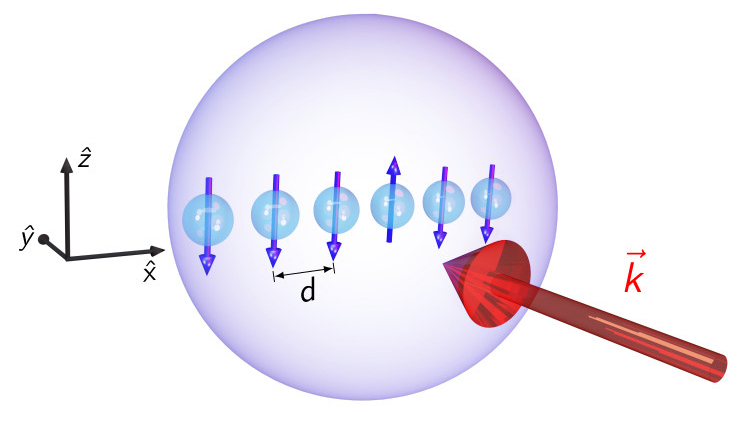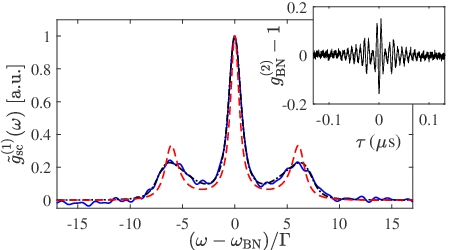Light Scattering by Cold Atoms - Theory
Leader: Romain Bachelard (romain@df.ufscar.br)
Collaborators: Philippe W Courteille, Celso J Villas-Boas, Raul C Teixeira
Localization of light
Group: Sheilla Oliveira, Noel A Moreira

After several years of controversy, the experimental observation of Anderson localization of light in 3D remains a challenge: The polarization of light makes it different from other waves (acoustic, matter, etc), and the associated near-field terms seem to be an obstacle to achieving localization.
Our group investigates theoretically the conditions under which the localization could be possible, and the true signatures of localization (light statistics, transmission). Studying both 2D and 3D systems, we aim at understanding how disorder could be manipulated to restore localization, how interactions would affect it and how the phase transition from conductor to insulator could be unambiguously monitored.
[1] F. Cottier, A. Cipris, R. Bachelard, R. Kaiser, Phys. Rev. Lett. 123, 083401 (2019)
[2] C. E. Máximo, N. A. Moreira, R. Kaiser, R. Bachelard, Phys. Rev. A 100, 063845 (2019)
[3] N. A. Moreira, R. Kaiser, R. Bachelard, Europhysics Letters 127, 54003 (2019)
Many-body physics in cold atoms with dipole-dipole interactions
Group: André Cidrim, Alan C Santos, Jorge Attie, Carlos E Máximo

Dipole-dipole interactions give rise to a broad range of 'collective' phenomena in cold atomic clouds scattering light. Its hallmark is superradiance, and its 'dark' counterpart has been labelled subradiance: These short-lived and long-lived modes are probed by switching on and off a probe laser, which allows to explore the joint emission of the atoms.
As the atoms are saturated by the laser, the interactions between atomic excitations rise, and one enters the realm of many-body physics. The challenge we address is to understand how to generate and harness quantum correlations, and possibly entanglement. Superradiant and subradiant modes can be thought as 'write/read' and 'storage' modes, turning these systems in promising platforms for quantum information processing.
[1] A. Cidrim, T. S. do Espirito Santo, J. Schachenmayer, R. Kaiser, and R. Bachelard, Phys. Rev. Lett. 125, 073601 (2020)
[2] T. S. do Espirito Santo, P. Weiss, A. Cipris, R. Kaiser, W. Guerin, R. Bachelard, J. Schachenmayer, Phys. Rev. A 101, 063845 (2020)
[3] W. Guerin, T.S. do Espirito Santo, P. Weiss, A. Cipris, J. Schachenmayer, R. Kaiser, and R. Bachelard, Phys. Rev. Lett. 123, 243401 (2019)
Correlations in the light scattered by many-atom clouds
Group: Elnaz Darsheshdar, Jhon F C Rojas

The collective emission of the atoms due to dipole-dipole interactions lead correlations in the photons emitted, both from a classical and quantum perspective. Interactions then turn into a tool to manipulate the photonic emission of the system, and thus mold the flow of light.
Our objective is to understand how the light statistics can be manipulated using interactions, using classical and quantum correlations between the atomic emitters. Subradiant and superradiant modes can then turn into 'collective emitters', provided one can address them specifically.
[1] D. Ferreira, R. Bachelard, W. Guerin, R. Kaiser and M. Fouché, Am. J. of Phys. 88, 831 (2020)
[2] L. Ortiz-Gutiérrez, R. C. Teixeira, A. Eloy, D. F. da Silva, R. Kaiser, R. Bachelard, M. Fouché, New J. of Phys. 21, 093019 (2019)
[3] E. Suarez, D. Auwäarter, T. J. Arruda, R. Bachelard, P. W. Courteille, C. Zimmermann, S. Slama, New J. Phys. 21, 035009 (2019)
[4] N. Piovella, R. Celistrino Teixeira, R. Kaiser, Ph.W. Courteille, and R. Bachelard, Phys. Rev. A 96, 053852 (2017)
[5] L. Pucci, A. Roy, T. S. do Espirito Santo, R. Kaiser, M. Kastner, and R. Bachelard, Phys. Rev. A 95, 053625 (2017)
